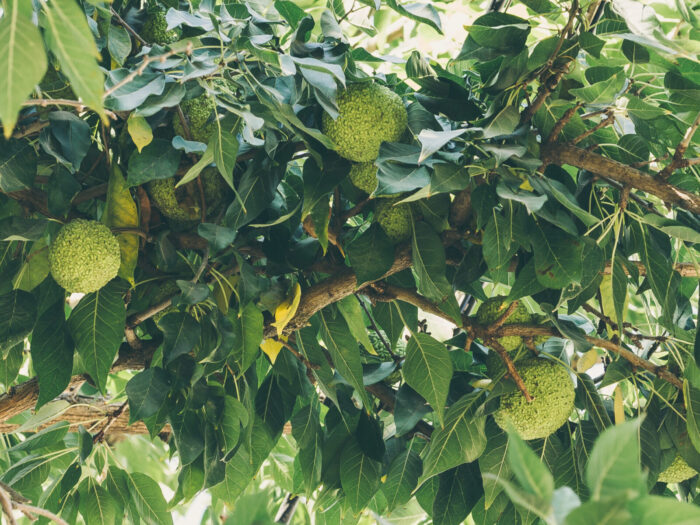Description
Latin Name: Maclura pomifera
Other Common Names: bodark, bow wood, hedge apple, hedge-apple, mock orange
Hardiness Zones: 4-10
Mature Size: Typically grows 35-60 ft (10-18 m) tall with a wide, round crown. Can also be cultivated as a large hedge shrub (Missouri Botanical Garden).
Preferred Soil and Climate: Prefers well-drained, moist soil in full sun to part shade. It adapts well to dryer soils and can tolerate cold, wet, dry, heat, wind, drought, and poor soils (Missouri Botanical Garden). Native to southern Arkansas, Oklahoma, and eastern Texas, it is naturalized widely from New England and Michigan south to Texas and Oregon, also found in the Pacific Northwest.
Additional Notes: Forms suckers and often grows in large colonies. Named for its orangish wood and bark, the Osage Orange tree has historical significance to the Osage Native American group (Missouri Botanical Garden). Bark is orange-brown with scales and ridges as it matures (Virginia Tech). Leaves are ovate, dark green, shiny, turning yellow in fall. Twigs are thorny, especially on new suckers, with milky sap. Flowers appear in June in greenish clusters; female trees require pollination by a male to produce fruit. Fertilized female flowers yield fruits that are 3-5 in (7-13 cm) wide, wrinkled, light green hedge apples, emitting a citrus smell when crushed (Missouri Botanical Garden). These fruits are not edible and are actually clusters of many small fruits. Despite its name, the Osage Orange is unrelated to oranges but belongs to the fig family. The fruit is prized for its insect-repelling properties when placed around foundations. The hard wood is durable and valued for making recurve bows, as practiced by Native Americans (Missouri Botanical Garden). Both male and female plants are necessary for fruit production, which cannot be determined until plants mature from seed.
Common Issues: Generally free of major problems, though fallen fruits can become litter concerns (Missouri Botanical Garden).
Cold Stream Farm supplies Osage Orange trees which are grown as bare root seedlings and transplants and sold both wholesale and retail with no minimum order.
Sources:
Missouri Botanical Garden: Maclura pomifera
- Virginia Tech Dendrology: Osage Orange Fact Sheet
Additional information on Maclura pomifera can be found on the link: USDA / NRCS PLANTS Database.











Taylor –
Trees arrive protected and healthy. Adaption and survival rate is high for this species.
Jacob Calvit –
Great product. Rootis were very strong and fiberous. A very hardy species.